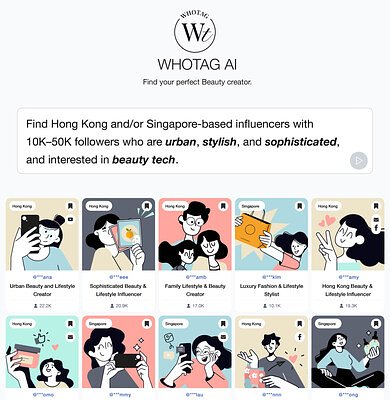
AI-Powered WHOTAG Aims to Decode Global Influencer Landscape
South Korean firm VAIV launches WHOTAG, an AI platform promising to revolutionize influencer discovery by cutting through cultural and linguistic barriers. Is this the future of global marketing?
AI-Powered WHOTAG Aims to Decode Global Influencer Landscape
Seoul, South Korea – In an era where authenticity often feels lost in the noise of social media, finding the right influencer to connect with target audiences is a growing challenge for brands. Now, South Korean AI firm VAIV is hoping to solve that problem with WHOTAG, a newly launched AI-powered SaaS platform designed to revolutionize influencer discovery, particularly in international markets.
After a beta period spanning 109 countries, WHOTAG officially launched globally this week, promising to move beyond simple hashtag searches and manual vetting. Unlike traditional methods, WHOTAG leverages GPT-based profiling to analyze content style, cultural context, and even nuanced linguistic signals, aiming to match brands with influencers who genuinely resonate with specific demographics.
“The biggest pain point for global marketers isn’t finding influencers, it’s finding the right influencers, those who understand the local culture and speak the language of the target audience,” explains a source familiar with VAIV’s development process. “Current tools often fall short, leading to ineffective campaigns and wasted resources.”
Beyond Keywords: Decoding Cultural Nuance
WHOTAG's core innovation lies in its ability to move beyond simple keyword analysis. The platform delves into the subtext of influencer content, recognizing subtle cultural references, slang, and even implied meanings. This is particularly crucial in markets where direct translation can be misleading or even offensive.
“Imagine you’re launching a campaign in Japan,” explains an industry analyst. “A direct translation of your marketing message might not resonate with the local audience. WHOTAG helps brands identify influencers who understand those cultural nuances and can communicate the message in a way that feels authentic and relevant.”
The platform’s AI reportedly analyzes not just the words an influencer uses, but how they use them. This includes tone, sentiment, and even the visual aesthetic of their content. The goal is to identify influencers whose values and brand alignment genuinely match the client’s objectives.
The Creator Economy: Opportunity and Scrutiny
While the influencer marketing industry continues to boom – projected to reach over $50 billion by 2027 – it’s also facing increased scrutiny. Concerns about authenticity, transparency, and the potential for exploitation are growing.
“The creator economy is a double-edged sword,” states a marketing professional specializing in brand safety. “It offers incredible opportunities for brands to connect with consumers, but it also comes with risks. Fake followers, undisclosed sponsorships, and a lack of accountability are major concerns.”
WHOTAG appears to be addressing some of these concerns by incorporating features designed to detect fraudulent activity and verify influencer authenticity. However, the platform’s effectiveness in preventing these issues remains to be seen.
Korean Innovation on the Global Stage
WHOTAG’s launch marks a significant moment for the Korean tech sector, which is increasingly making its mark on the global stage. South Korea has emerged as a hub for innovation in areas like AI, data analytics, and mobile technology.
“Korea has a unique ecosystem that fosters innovation,” explains a tech investor with a focus on the Asian market. “Strong government support, a highly educated workforce, and a culture of entrepreneurship have created a fertile ground for startups.”
VAIV’s decision to launch WHOTAG globally suggests a growing confidence in the potential of Korean technology to disrupt international markets. The company is betting that its AI-powered platform can offer a more effective and efficient solution for brands looking to connect with consumers around the world.
However, WHOTAG faces stiff competition from established players like Upfluence, Klear, and HypeAuditor, all of whom offer similar influencer discovery tools. To succeed, VAIV will need to demonstrate a clear differentiation based on its AI capabilities, cultural sensitivity, and commitment to transparency.
The Future of Influencer Marketing?
The success of WHOTAG could signal a shift in the influencer marketing landscape, moving away from broad-stroke campaigns and towards more targeted, culturally relevant activations. If the platform can deliver on its promise of identifying authentic and engaging influencers, it could help brands build stronger relationships with consumers and achieve better marketing results.
“The days of simply partnering with influencers based on follower count are over,” says an anonymous source within VAIV. “Brands are now looking for influencers who can genuinely connect with their target audience and drive meaningful engagement. WHOTAG is designed to help them find those influencers.”
Whether WHOTAG will revolutionize the industry remains to be seen, but its launch is undoubtedly a significant development. As the creator economy continues to evolve, platforms that prioritize authenticity, transparency, and cultural sensitivity will be best positioned to succeed. The question now is whether WHOTAG can effectively decode the complexities of the global influencer landscape and deliver on its promise of a more effective and efficient marketing solution.
